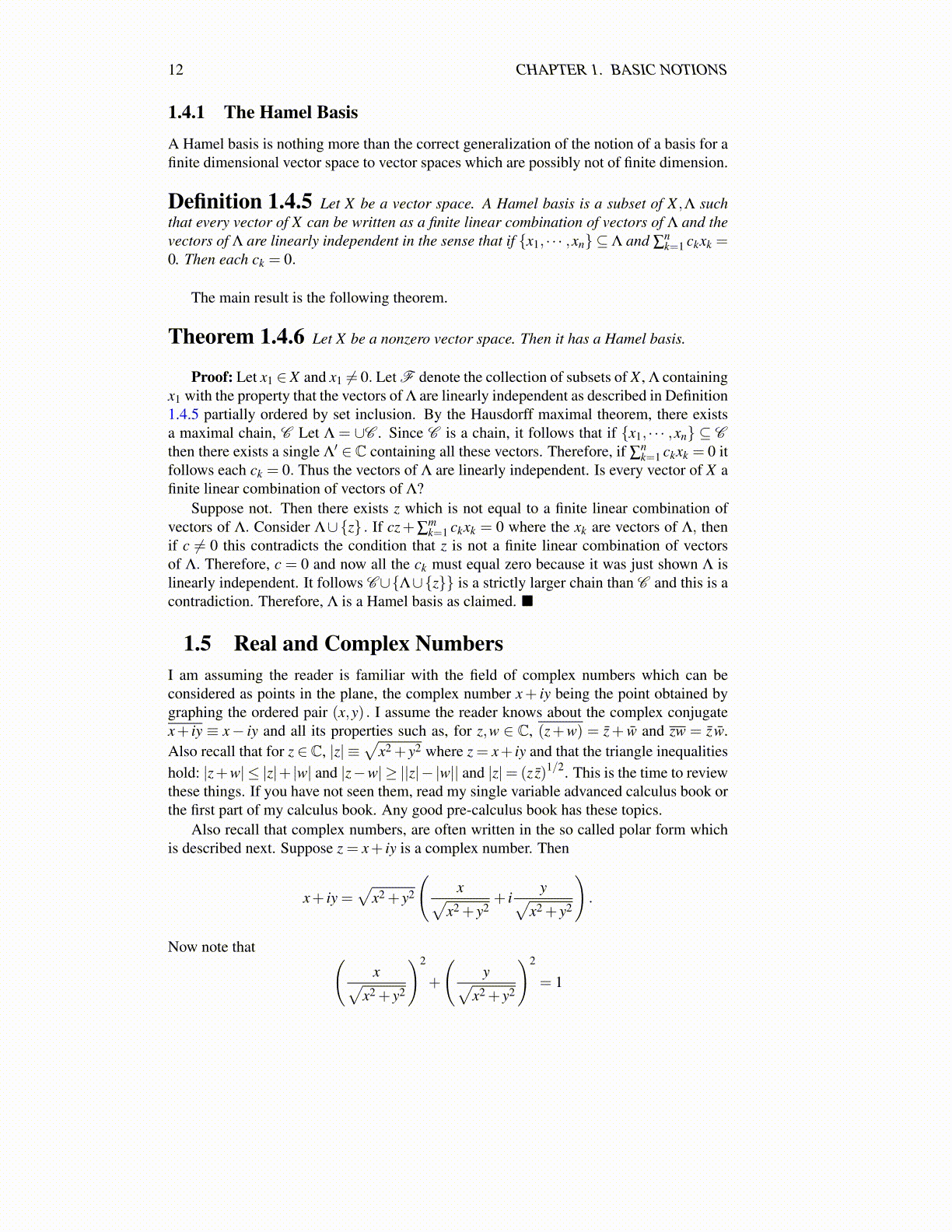
12 CHAPTER 1. BASIC NOTIONS
1.4.1 The Hamel Basis
A Hamel basis is nothing more than the correct generalization of the notion of a basis for afinite dimensional vector space to vector spaces which are possibly not of finite dimension.
Definition 1.4.5 Let X be a vector space. A Hamel basis is a subset of X ,Λ suchthat every vector of X can be written as a finite linear combination of vectors of Λ and thevectors of Λ are linearly independent in the sense that if {x1, · · · ,xn} ⊆ Λ and ∑
nk=1 ckxk =
0. Then each ck = 0.
The main result is the following theorem.
Theorem 1.4.6 Let X be a nonzero vector space. Then it has a Hamel basis.
Proof: Let x1 ∈ X and x1 ̸= 0. Let F denote the collection of subsets of X , Λ containingx1 with the property that the vectors of Λ are linearly independent as described in Definition1.4.5 partially ordered by set inclusion. By the Hausdorff maximal theorem, there existsa maximal chain, C Let Λ = ∪C . Since C is a chain, it follows that if {x1, · · · ,xn} ⊆ Cthen there exists a single Λ′ ∈ C containing all these vectors. Therefore, if ∑
nk=1 ckxk = 0 it
follows each ck = 0. Thus the vectors of Λ are linearly independent. Is every vector of X afinite linear combination of vectors of Λ?
Suppose not. Then there exists z which is not equal to a finite linear combination ofvectors of Λ. Consider Λ∪{z} . If cz+∑
mk=1 ckxk = 0 where the xk are vectors of Λ, then
if c ̸= 0 this contradicts the condition that z is not a finite linear combination of vectorsof Λ. Therefore, c = 0 and now all the ck must equal zero because it was just shown Λ islinearly independent. It follows C∪{Λ∪{z}} is a strictly larger chain than C and this is acontradiction. Therefore, Λ is a Hamel basis as claimed. ■
1.5 Real and Complex NumbersI am assuming the reader is familiar with the field of complex numbers which can beconsidered as points in the plane, the complex number x+ iy being the point obtained bygraphing the ordered pair (x,y) . I assume the reader knows about the complex conjugatex+ iy ≡ x− iy and all its properties such as, for z,w ∈ C, (z+w) = z̄+ w̄ and zw = z̄ w̄.Also recall that for z ∈C, |z| ≡
√x2 + y2 where z = x+ iy and that the triangle inequalities
hold: |z+w| ≤ |z|+ |w| and |z−w| ≥ ||z|− |w|| and |z|= (z z̄)1/2. This is the time to reviewthese things. If you have not seen them, read my single variable advanced calculus book orthe first part of my calculus book. Any good pre-calculus book has these topics.
Also recall that complex numbers, are often written in the so called polar form whichis described next. Suppose z = x+ iy is a complex number. Then
x+ iy =√
x2 + y2
(x√
x2 + y2+ i
y√x2 + y2
).
Now note that (x√
x2 + y2
)2
+
(y√
x2 + y2
)2
= 1